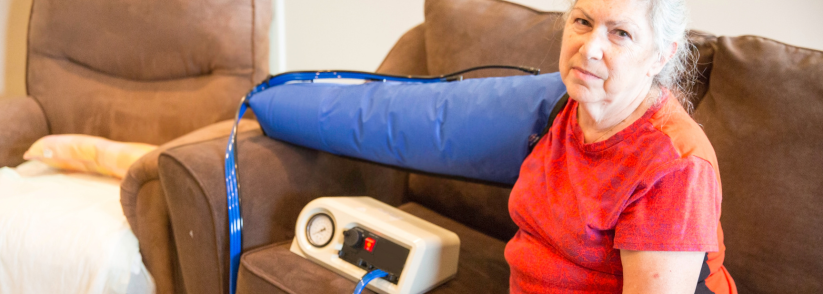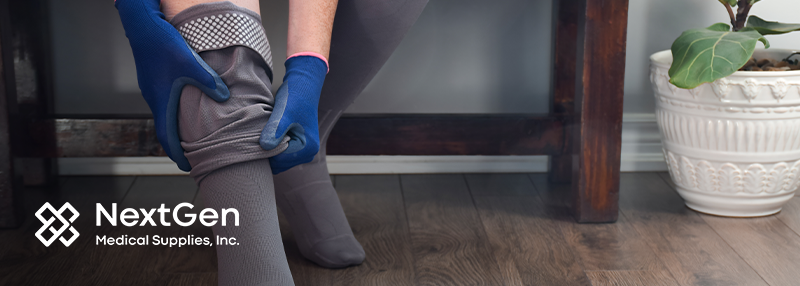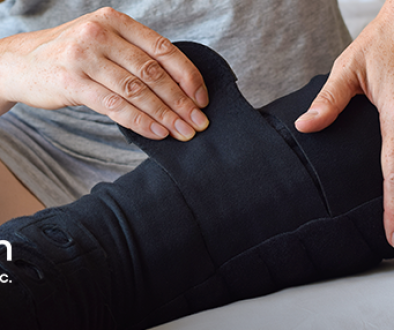Lymphedema Pump Basics: How Compression Helps Swelling, Comfort, and Mobility
October is Breast Cancer Awareness Month, a time to honor survivors and raise awareness about the long-term effects of treatment. One common condition that many survivors face is lymphedema, a chronic buildup of fluid that causes swelling, discomfort, and reduced mobility, most often in the arms or legs.
For many breast cancer survivors, especially those who have had lymph nodes removed or received radiation therapy, lymphedema becomes an ongoing challenge. Fortunately, lymphedema pumps, also known as home compression pumps, offer an effective way to manage symptoms and improve daily comfort.
What Is Lymphedema and Why Does It Happen?
Lymphedema occurs when the lymphatic system is damaged or blocked, preventing lymph fluid from draining properly. This causes fluid to collect in tissues, leading to swelling, tightness, and sometimes pain. It’s especially common after breast cancer treatment involving lymph node removal or radiation therapy.
Common symptoms include:
- Swelling in the arm, leg, chest, or trunk
- A feeling of heaviness or tightness
- Reduced range of motion
- Skin changes or a higher risk of infection
How Compression Therapy Helps
Compression therapy is one of the most effective ways to manage lymphedema. It works by applying gentle, controlled pressure to the affected area, helping move trapped lymph fluid back into circulation.
Lymphedema pumps, or intermittent pneumatic compression (IPC) devices, use inflatable sleeves with multiple chambers that inflate and deflate in a sequence. This action mimics the body’s natural lymphatic flow, helping reduce swelling, improve comfort, and restore mobility.
Benefits of home compression therapy:
- Noticeable swelling reduction and limb-size control
- Better mobility and range of motion
- Increased comfort and reduced heaviness
- Convenient home use with customizable settings

What to Expect When Using a Lymphedema Pump at Home
Using a lymphedema pump at home is simple and can be highly effective when done correctly. Always follow your healthcare provider’s guidance and the device instructions.
Best practices include:
- Consult your healthcare provider or certified lymphedema therapist before starting pump therapy.
- Choose the correct sleeve size to ensure even, effective compression.
- Start with shorter sessions (15–30 minutes) and increase gradually as advised.
- Use the pump consistently, ideally once daily, to maintain results.
- Combine pump use with manual lymphatic drainage, compression garments, and gentle exercise for best outcomes.
Tips for Safe and Effective Use of Compression Pumps
Here are some additional tips to keep you safe while using your home compression pump effectively:
- Avoid use during active infections or on open wounds.
- Keep the skin clean and moisturized to prevent irritation.
- Elevate the limb after each session to enhance fluid return.
- Monitor for any changes in swelling, skin condition, or pain, and contact your provider if symptoms worsen.

Why This Matters During Breast Cancer Awareness Month
Up to 40% of breast cancer survivors develop some level of lymphedema, often in the arm or chest area. Early management and consistent home care can make a significant difference in long-term comfort and mobility.
By understanding how compression therapy works and using tools like lymphedema pumps, patients and caregivers can take proactive steps toward recovery, independence, and improved quality of life.
Explore Lymphedema Pump Options with NextGen Medical Supplies
At NextGen Medical Supplies, we provide a range of home compression pumps designed to help you manage lymphedema safely and comfortably. Our compassionate team can help you find the right solution for your needs, and guide you through insurance coverage, setup, and follow-up care!
Take the first step toward swelling relief and greater mobility. Contact NextGen Medical Supplies to learn more about our lymphedema compression options.

